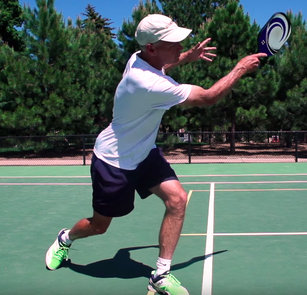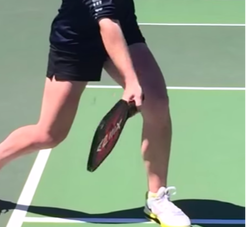|
Do you need an elbow brace or strap to help you get through your regular pickleball games? What if I told you there’s a BETTER way to manage your elbow pain AND prevent it from coming back? If you’re willing to devote ten minutes per day to a few exercises and some self-massage techniques, there’s a good chance you can ditch that elbow strap and get back to the court WITHOUT pain and with improved motion in your arm to have you playing at the top of your game?
If you’re having pain on the outside of your elbow, there’s a good chance you could have lateral epicondylitis, or more commonly known as “tennis elbow.” This condition can also occupational, such as with people who turn a wrench for a living or perform any task involving repetitive twisting of the forearm. I even have seen a pastor with this condition, which he attributed to doing some renovations around his church (talk about hands on!) He was actually a pretty decent golfer too (though not playing frequently at the time) which may have irritated the area previously. Here are four simple do-it-yourself interventions plus one simple treatment that work quite reliably when done consistently. If these approaches don’t resolve your pain AND help you return to the pickleball court, the next step would be to seek help from a rehab professional who has other techniques available and can also look for potential causes such as in shoulder function. Mobilization with movement – Whether performed on yourself or delivered by a professional, this is the “go-to” technique for persistent tennis elbow. Both options are shown below. Note that you can vary the angle of arm bend to provide different stimuli to the area, as patients can vary in which angle works best for them. Typically the treatment is performed by applying lateral pressure and then having the patient grip and release, though you’ll find different variations on the same theme commonly practiced. The key point here is that PAIN SHOULD REDUCE with this treatment. If pain is getting worse, this likely isn’t the right treatment for you. Which is fine, because there are other options….
0 Comments
Pickleball seems like simple game on the surface, which is part of its appeal and massive growth recently. But like many things, there’s a lot more to the game. Take the forehand for example. It’s a relatively simple shot that even the most rudimentary beginner will naturally attempt even without coaching. While refining your fundamentals it is vital to understand whether your body has the underlying capabilities to achieve those more complex positions and movements. If you’re trying to rotate more, you must ask what are the joint requirements to achieve that rotation? Here are three essential physical qualities that you must cultivate to achieve an optimal forehand for your body and more importantly, stay healthy. 1) Lead hip internal rotation For a basic forehand where you have time to set up for the shot (not running off balance), the ability to internally rotate your lead hip (the L hip for a right-handed player) is essential. A simple way to illustrate internal rotation: stand normally with your feet pointed forward and then try to turn your pelvis to the left without moving your feet. That motion occurring at your left hip is internal rotation. Why is this important in pickleball? When you plant your front foot during a forehand, much of the rotation through the shot comes from internal rotation of the lead hip. Yes, some other parts of the body rotate as well, but the hip is a critical piece. If you lack hip internal rotation and don’t make appropriate accommodations with stroke technique, you may find the shot ineffective, or at worst, injurious if repeated several thousand times over a playing career. Here's a quick way to assess and train your hip internal rotation from the Functional Range Conditioning library 2) Upper and lower body disassociation This might sound like a complex term but fear not, it is actually quite an intuitive concept. The transition from the backstroke begins with the transfer of pressure from the trail leg (right for a right-handed player) toward the lead leg. This move is initiated from the lower body WHILE the upper body stays back momentarily. After that shift has occurred in the lower body, then the upper body begins to rotate through. Why is “disassociation” important in pickleball? If you can’t move your lower body and upper body independently of each other, your stroke will be a mess. Watch a toddler try to swing a bat or racket and you’ll see what poor dissociation looks like as they turn their body as a single unit rather than with a gradual progression of forces. Here is a simple drill to both assess and train dissociation. 3) Trail wrist extension For a right handed player the trail wrist is the right wrist. Wrist extension is when you bend your wrist up, the direction opposite from your palm. If you lack wrist extension your body may be forced to compensate elsewhere, which is one reason we see shoulder and elbow injuries so common in the sport. Wrist position will certainly change based on the type of shot but for the forehand some amount of extension is necessary. Note that wrist extension is also important for many activities of daily living such as driving or helping rise from a seated position. Summary
These are just three motions, but they are three of the most important. Injury prevention is more than just a good warmup and some stretching; it also means building a game that matches your body’s capabilities and molding your body to meet the specific demands of your game. If you need any assistance with a movement assessment specific to your demands on the pickleball court, please don’t hesitate to reach out to us! |
AuthorAllan Phillips, PT, DPT is owner of Ventana Physiotherapy Archives
December 2023
Categories
All
|
2951 N. Swan Rd.
Suite 101, inside Bodywork at Onyx
Tucson, Arizona 85712
Call or Text: (520) 306-8093
[email protected]
Terms of Service (here)
Privacy Policy (here)
Medical disclaimer: All information on this website is intended for instruction and informational purposes only. The authors are not responsible for any harm or injury that may result. Significant injury risk is possible if you do not follow due diligence and seek suitable professional advice about your injury. No guarantees of specific results are expressly made or implied on this website.
Privacy Policy (here)
Medical disclaimer: All information on this website is intended for instruction and informational purposes only. The authors are not responsible for any harm or injury that may result. Significant injury risk is possible if you do not follow due diligence and seek suitable professional advice about your injury. No guarantees of specific results are expressly made or implied on this website.
Proudly powered by Weebly



 RSS Feed
RSS Feed